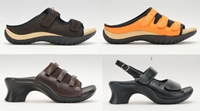 Akaishi (Shizuoka, Japan) has a very simple philosophy: Strive for 100 percent confidence in product functionality. This assures customer satisfaction and long-term success for the company's lines of correctional footwear, massaging footwear and facial massage devices.
Akaishi (Shizuoka, Japan) has a very simple philosophy: Strive for 100 percent confidence in product functionality. This assures customer satisfaction and long-term success for the company's lines of correctional footwear, massaging footwear and facial massage devices.
To create an ArchFitter™ or FootOne™ sandal, Akaishi's product development begins with concept design, blends in biomedical research and finishes with a 3D CAD model. Next, the sandal's "last," (a foot-shaped form), is evaluated before proceeding with tooling. Prototyping this form, however, proved to be a challenge.
Restrictions allowed just one prototype and one chance to get the design right, which caused difficulties verifying functionality as thoroughly as the development team desired. "The limitations were lead time and cost for the prototype," says Akaishi's Mr. Makoto Muraoka. "Outsourcing to local service bureaus had a 10-day lead time and high expense for a single round of prototyping of an unverified design. And we still needed additional prototyping service after design changes. Such a process presents a major challenge for Akaishi, a manufacturer aiming for short-term development."
Real Solution
To rectify the problem, Akaishi purchased a Dimension 3D printer. "We bought the Dimension to bring prototyping back inhouse," says Muraoka. "Now, we can verify the functionality as much as we want because the cost to make prototypes is low." The cost of a sandal last has dropped to just JPY 10,000, which is an average 73 percent decrease from the outsourced price. The Dimension also reduced lead times to just one day. Now, Muraoka noted, "We can make 10 prototypes, if needed, to verify product design," (table 1).
The Dimension system allowed Akaishi to increase prototype iterations for its various product lines and improve designs, but a new challenge arose. During functional testing of a Natural Brand™ face massager, its slender arms could not take the pressure.
"We needed to use actual mass-production material, or similar, to fully verify its functionality." One option that was quickly abandoned was the use of five-axis milling to machine prototypes or molds. "It was impossible to adopt CNC machining due to the limited number of laborers on the team," says Muraoka.
Building from the success of the 3D printer, Akaishi looked into other additive fabrication options. "We investigated 3D production systems for stiffer materials and focused on the Fortus line from Stratasys," says Muraoka. Like Dimension, Fortus systems are easy to use, but they offer a range of advanced thermoplastic materials, which convinced Akaishi to install one.
Using the system to make polycarbonate prototypes, Akaishi has tested designs without breakage even when strong forces were applied. "Thanks to polycarbonate material, we can verify the design with a material similar to that used in mass production." Yet, the product development group wanted even more from its prototypes. Muraoka says that while the polycarbonate was a good match, "It is best to use the exact same material as that used in production." This meant that injection molds were needed.
Using FDM, Akaishi produced manually operated injection molds from PPSF (PPSU/polyphenylsulfone). The material has high heat and chemical resistance and is very stiff. "We soon made a simplified tool with PPSF, and we injection molded polyamide (nylon), polypropylene, elastomer and other resins for evaluation," Muraoka says.
The face massager mold cost just JPY 2,000, a 99 percent reduction from a machined injection mold. And it was complete in one day rather than 14 days if cut with a CNC mill.
Akaishi used the PPSF tool to mold ten prototype massager handles in each of the plastics being considered. It used these to confi rm functionality and evaluate materials. "We evaluated ease-of-use with the prototypes and finally found nylon to be the best material to make the face massager fit to the cheek."
Real Benefits
The success of this project has given the product development group proof that it can use PPSF tools to injection mold prototypes with mass-production materials. "When we make these molds, we can verify not just the product geometries, but also their materials in advance," says Muraoka. "The 3D production system allows us to perform a wider range of verifi cation. We can say this is surely the ultimate method of verifi cation!" And that gives Akaishi the 100 percent confi dence in product functionality for which it strives.





























































































